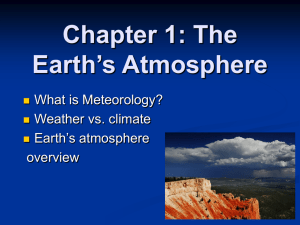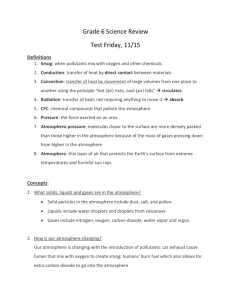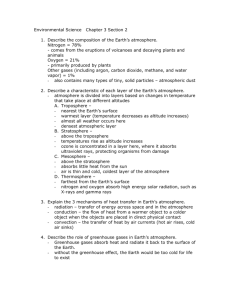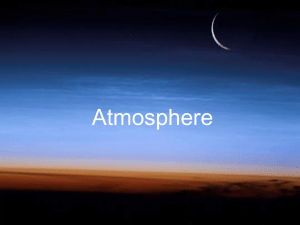Temperature
advertisement
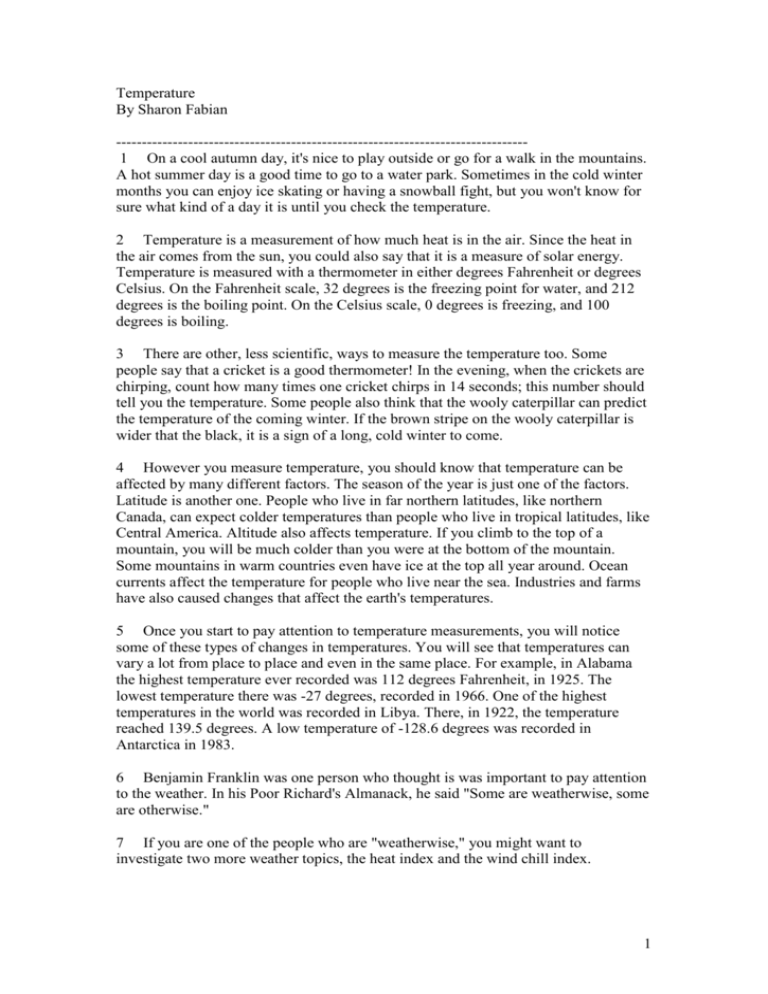
Temperature By Sharon Fabian -------------------------------------------------------------------------------1 On a cool autumn day, it's nice to play outside or go for a walk in the mountains. A hot summer day is a good time to go to a water park. Sometimes in the cold winter months you can enjoy ice skating or having a snowball fight, but you won't know for sure what kind of a day it is until you check the temperature. 2 Temperature is a measurement of how much heat is in the air. Since the heat in the air comes from the sun, you could also say that it is a measure of solar energy. Temperature is measured with a thermometer in either degrees Fahrenheit or degrees Celsius. On the Fahrenheit scale, 32 degrees is the freezing point for water, and 212 degrees is the boiling point. On the Celsius scale, 0 degrees is freezing, and 100 degrees is boiling. 3 There are other, less scientific, ways to measure the temperature too. Some people say that a cricket is a good thermometer! In the evening, when the crickets are chirping, count how many times one cricket chirps in 14 seconds; this number should tell you the temperature. Some people also think that the wooly caterpillar can predict the temperature of the coming winter. If the brown stripe on the wooly caterpillar is wider that the black, it is a sign of a long, cold winter to come. 4 However you measure temperature, you should know that temperature can be affected by many different factors. The season of the year is just one of the factors. Latitude is another one. People who live in far northern latitudes, like northern Canada, can expect colder temperatures than people who live in tropical latitudes, like Central America. Altitude also affects temperature. If you climb to the top of a mountain, you will be much colder than you were at the bottom of the mountain. Some mountains in warm countries even have ice at the top all year around. Ocean currents affect the temperature for people who live near the sea. Industries and farms have also caused changes that affect the earth's temperatures. 5 Once you start to pay attention to temperature measurements, you will notice some of these types of changes in temperatures. You will see that temperatures can vary a lot from place to place and even in the same place. For example, in Alabama the highest temperature ever recorded was 112 degrees Fahrenheit, in 1925. The lowest temperature there was -27 degrees, recorded in 1966. One of the highest temperatures in the world was recorded in Libya. There, in 1922, the temperature reached 139.5 degrees. A low temperature of -128.6 degrees was recorded in Antarctica in 1983. 6 Benjamin Franklin was one person who thought is was important to pay attention to the weather. In his Poor Richard's Almanack, he said "Some are weatherwise, some are otherwise." 7 If you are one of the people who are "weatherwise," you might want to investigate two more weather topics, the heat index and the wind chill index. 1 8 The heat index combines information about temperature and humidity to tell us how hot it really feels. When the heat index is high, it is time to use some precautions to avoid heat-related accidents like sunstroke or heat exhaustion. Some common sense things people can do to beat the heat include slowing down their activity level or moving inside, wearing clothes that are both light in weight and light in color, and drinking plenty of water. 9 The wind chill index is a combination of temperature and wind speed. It tells us how cold it feels outside. When the wind chill index is high, people should wear layers of clothes to hold in their body heat. 10 Being "weatherwise" is an all-around good idea. It can help keep us safe, and can also help us plan that day at the beach or on the ski slopes. Copyright © 2007 edHelper -------------------------------------------------------------------------------- Name _____________________________ Date ___________________ Temperature 1. The main idea of this article is Benjamin Franklin High and low temperature records How to measure temperature Information about temperature 2. The two scales used to measure temperature are Fahrenheit and _____. Wind chill index Heat index Temperature Celsius 3. The word that tells how far north or south of the equator a place is located is _____. Latitude Tropical Altitude Season 4. This word tells how high a mountain is. Latitude Season Tropical Altitude 2 5. Using a cricket to measure temperature could best be described as _____. A lie Proven data Folklore Scientific fact 6. The heat index combines temperature and _____ to tell how hot it feels outside. Humidity Air pressure Wind speed Precipitation Name _____________________________ Date ___________________ Temperature 7. The wind chill index combines temperature and _____ to tell how cold it feels outside. Air pressure Humidity Precipitation Wind speed 8. Wind chill affects how cold people feel, but it doesn't affect things like how much antifreeze your car will need on a cold day, or whether the pipes in your house will freeze. Can you explain why? --------------------------------------------------------------------------------------------------------------------------------------------------------------- Temperature - Answer Key 1 2 3 4 5 6 Information about temperature Celsius Latitude Altitude Folklore Humidity 3 7 Wind speed 8 Wind chill only changed how cold it feels, not how cold it actually is. Storms By Sharon Fabian Dorothy had a bit of a problem. A tornado had lifted up Dorothy and her little dog Toto and carried them to the strange land of Oz. Tornadoes are like that; they cause problems wherever they go. So do other types of storms, like thunderstorms and blizzards. 1 One way to categorize storms is into two groups, summer storms and winter storms. Summer storms include several types of thunderstorms and tornadoes. Winter storms include blizzards, ice storms, lake effect storms, and the fierce nor'easters. 2 There are three main types of thunderstorms: single cells, multicell clusters, and multicell lines called squall lines. Single cell thunderstorms are the common everyday kind. They usually last from 20 to 30 minutes, and include downpours of rain, possible hail, thunder, and lightning. They are not the most dangerous type, but one danger from single cell storms is the possibility of a microburst. A microburst is a sudden burst of high wind that is especially dangerous to airplane pilots. Multicell clusters and squall lines are bigger storms that are more dangerous because they are larger and can last longer. One danger from any type of thunderstorm is the lightning. Lightning causes hundreds of deaths and millions of dollars in property damage each year. Another danger is the possibility of flash flooding. Flash floods are weather's biggest killer. 3 A super cell is a special kind of thunderstorm. It is one with winds that spin and spiral. Weather watchers keep a close eye on supercells because a supercell can develop into a tornado. 4 Tornadoes are powerful storms that can flatten even a sturdily built house. Tornadoes, like the fictional one in The Wizard of Oz, consist of a huge cloud with a tail that touches down on the ground. Tornadoes' spiraling winds make them especially hazardous. If you are in an area where a tornado is spotted, you should take cover in the basement or an inside room of your house, or in a low area such as a ditch if you are outside. 5 6 Blizzards are common winter storms. In a blizzard, the temperature 4 falls below 20 degrees, and there are high winds and snow. The winds and blowing snow in a blizzard make it difficult to see. Visibility in a blizzard is usually 1/4 mile or less. Ice storms don't happen very often, and when they do, they are usually a big surprise because ice storms occur in the southeastern states where winter storms are not common. Ice storms may include freezing rain, sleet, and snow. 7 Lake effect storms happen in the cold states around the Great Lakes where winter weather is expected. These storms happen when cool air moves over the warmer water of the lakes, causing precipitation to fall. 8 A nor'easter is one of the most ferocious winter storms. A nor'easter travels up the east coast until it gets to the New England states, or Canada, where it becomes a severe storm when it meets the cold air there. 9 With modern scientific advances, storms are more predictable today than they once were. Even so, storms still have immense power, and will always be a force to be reckoned with. It's no wonder that many authors, just like Mr. Baum who wrote The Wizard of Oz, chose to put a storm in their stories. 10 Copyright © 2007 edHelper Name _____________________________ Date ___________________ Storms 1. Single cell storms, multicell clusters, and multicell lines are three types of _____. Blizzards Thunderstorms Rain Tornadoes 3. The Wizard of Oz was _____. A non-fiction article A famous weather man A weather report A fiction story 2. Tornadoes develop from _____. Blizzards Ice storms Supercells Squall lines 4. A good way to organize types of storms is in two groups, _____ and _____. Spring storms and summer storms Winter storms and summer storms Thunderstorms and ice 5 storms Tornadoes and thunderstorms 5. An ice storm would be likely to happen in the state of _____. Hawaii Texas Alabama California 7. All of these storms involve _____. Rain and ice Precipitation and wind Rain and wind Spiraling winds and snow 6. It is dangerous to drive in a blizzard because of _____. The snow on the roads The spiraling winds The poor visibility Both a and c 8. This article is mainly about _____. Snow storms The Wizard of Oz Thunderstorms Types of storms 6 Storms - Answer Key 1 2 3 4 5 6 7 8 Thunderstorms Supercells A fiction story Winter storms and summer storms Alabama Both a and c Precipitation and wind Types of storms Air - The Atmosphere By Sharon Fabian When you get chilly, you might wrap up in a nice warm blanket. The earth has a blanket too, called the atmosphere. We call it air for short. The blanket of air that surrounds the earth keeps us comfortable. We wouldn't be able to live on Earth without an atmosphere. 1 Earth isn't the only planet with an atmosphere. Some planets have an atmosphere made up of toxic chemicals. Some big planets, like Jupiter, are all atmosphere. Earth, however, is the only planet that we know of, so far, that has an atmosphere that makes life possible. 2 Earth's atmosphere is made up of many different chemicals, most of them in very small amounts. The main chemicals in air are oxygen at 21%, nitrogen at 78%, and argon at less than 1%. Some other chemicals that are there in very small amounts are important too. There is carbon dioxide, water vapor, ozone, and man-made gasses including chlorofluorocarbons (CFC's). 3 The atmosphere is arranged in layers around the earth. The layer closest to the earth is the troposphere. It is a thin layer, only about seven to eight miles thick. The troposphere is where the clouds are. It's where thunderstorms, and all the rest of the weather happens. It's the part that recycles our water for us. It's where most of the airplanes fly. The next layer is the stratosphere. It's where the Concorde flew, and where some supersonic military planes fly. The stratosphere is where the ozone layer is. The mesosphere, the ionosphere, and the exosphere are beyond the stratosphere. The atmosphere in these three layers gradually gets thinner 4 7 and thinner until there is no atmosphere left. Beyond that is outer space. Think of all of the protective gear an astronaut must wear. The gear protects him or her from deadly hazards like extreme cold, and lack of oxygen. The rest of us are protected from these same hazards every day by the atmosphere. The atmosphere provides the oxygen that we breathe. It regulates the earth's temperature. It filters out dangerous solar radiation. It also recycles our water. 5 If you research to find information about the atmosphere, one of the first things that you will probably find is information about problems with the atmosphere, especially problems with the part called the ozone layer. The ozone layer is the lower part of the stratosphere, about twelve to fifteen miles above sea level. The ozone layer acts like a giant shield that protects the earth from the dangerous ultraviolet (UV) rays from the sun. 6 Scientists have found that the ozone layer is being worn away in spots by interactions with man-made chemicals, particularly CFC's. CFC's were once used a lot in products like spray cans and cooling systems. They seemed like very useful chemicals at the time; however the scientists later learned that CFC's collect in the stratosphere where they attack the ozone layer. A large hole has been discovered in the ozone layer over Antarctica. NASA scientists have an aircraft called NASA-ER2 that goes out to gather information about the ozone layer. The information is brought back to labs where scientists can study them and make hypotheses about what is happening in our atmosphere. Besides the hole over the Antarctic, they are also studying a smaller hole over the Arctic and other spots where the ozone layer is getting thinner. They are studying how volcanic eruptions affect the ozone layer, and how airplane exhaust contributes to the problem. 7 Scientists are gathering and studying more and more data all the time, but one thing that they have learned for sure is that the atmosphere is a thin, fragile blanket of air. It's done a beautiful job of protecting us so far, but everything that people do affects the atmosphere in one way or another. If we like our air just the way it is, we'll all have to do our part to keep it in good shape. 8 Copyright © 2007 edHelper Name _____________________________ Date ___________________ Air - The Atmosphere 8 1. Atmosphere is another word for 2. The layer of the atmosphere _____. Air Troposphere Stratosphere Ozone 3. The ozone layer is part of the _____ layer. Troposphere Stratosphere Ionosphere Mesosphere 5. CFC's _____. Are short for chlorofluorocarbons Are man-made chemicals Attack the ozone layer All of the above 7. The NASA-ER2 mainly does which step of the scientific method? Make hypotheses Analyze data Gather information Draw conclusion where thunderstorms happen is the _____. Mesosphere Stratosphere Troposphere Ionosphere 4. The _____ is farthest away from the earth. Troposphere Mesosphere Stratosphere Ionosphere 6. Here on earth, we don't have to wear protective gear like the astronauts do, because _____. We stay indoors most of the time It is cooler here Outer space has a poisonous atmosphere The atmosphere protects us here 8. Our atmosphere contains _____. A balanced amount of many different chemicals that makes life on earth possible Only oxygen, nitrogen, argon, ozone, water vapor, and CFC's A toxic mix of chemicals like many other planets in the solar system Only oxygen 9 Air - The Atmosphere - Answer Key 1 Air 2 Troposphere 3 Stratosphere 4 Ionosphere 5 All of the above 6 The atmosphere protects us here 7 Gather information 8 A balanced amount of many different chemicals that makes life on earth possible Global Warming By Patti Hutchison You know that the sun is the source of all energy on earth. But sometimes we get a double dose of that energy. Solar radiation reaches the earth. The earth soaks up some of it and reflects some back to the atmosphere. The reflected radiation is absorbed by the gases in the atmosphere. The gases act like the glass walls of a greenhouse. They trap the warm air in and reflect it back to earth again. Scientists call this the greenhouse effect. 1 You may have heard that the greenhouse effect is a bad thing. But the truth is life could not exist on earth without it. Our planet would be cold. However, an increase in the greenhouse effect would make earth too hot. Many scientists think that this is happening now. There is an increase in carbon dioxide. This is causing an increase in the greenhouse effect. The earth is warming up. 2 Temperatures around the earth have steadily gone up over the past 200 years. The past twenty years have seen the biggest increase. If this continues, it could have a shocking effect on the earth. People's lives could be changed in a negative way. 3 Most scientists agree that global warming is happening. What they disagree on, though, is what is causing it. The greenhouse effect happens 4 10 naturally. There is proof that the climate of the earth has warmed up and cooled down in the past. But data show that the population is growing. So is the amount of carbon dioxide in the air. Are people causing global warming? If so, what effects will this have on the earth? Many scientists think that global warming is caused by human activities. Every time we drive a car, we put carbon dioxide in the air. We burn a lot of fossil fuels such as coal and oil. This gives off a lot of carbon dioxide. Cutting of the rainforests is also causing more carbon dioxide in the atmosphere. Plants take in carbon dioxide during photosynthesis. If there are fewer plants, this will not happen. 5 Climatic changes happen very slowly. It will take a long time to see the effects of global warming. There are two different theories. Some scientists think that the warming will cause the polar ice caps to melt. This will cause the oceans to rise. Coastal cities could be flooded. Other scientists have a different idea. If the air over Antarctica warms up, it can hold more moisture. This would mean more snow. The ice caps might get larger. We might even have another ice age. 6 There are other changes in our weather due to global warming. Sea level has risen over four inches in the past 100 years. More water can be evaporated. This is causing more precipitation. There have been strong rain storms in parts of the U.S. This has caused massive mud slides and flooding. There has been an increase in violent storms such as tornadoes and hurricanes. They have caused a lot of injury and property damage. 7 What can be done about global warming? Can one person make a difference? The answer is YES! If we conserve energy we will use less fossil fuel. Turn off appliances and lights when you're not using them. Wear a sweater instead of turning up the thermostat in the winter. Open the windows instead of using the air conditioner in the summer. Ride your bike instead of driving short distances. Always recycle everything you can. If we all work together to conserve, the earth will be a lot better off. 8 Copyright © 2007 edHelper Name _____________________________ Date ___________________ Global Warming 1. What is the source of all energy on earth? 2. Gases in the atmosphere act like: 11 Fossil fuels The sun The greenhouse effect Violent storms Polar ice caps Walls of a greenhouse 3. The greenhouse effect is always 4. Name two effects global bad for the earth. False True 5. Name two activities that put more carbon dioxide in the air. warming is having on our weather. 6. What has happened to the level of the ocean over the past 100 years? It has increased. It has stayed the same. It has decreased. 12 Global Warming - Answer Key 1 The sun 2 Walls of a greenhouse 3 False 4 More precipitation; increase in tornadoes and hurricanes 5 Driving a car; burning fossil fuels; cutting the rainforests (any two) 6 It has increased. What Is the Atmosphere? By Patti Hutchison Earth, air, water, and fire. The ancient Greeks thought these were the basic elements. They believed these could not be broken down into parts. Today, we know more about the air around us. It is made up of many gases. Together these gases make up the atmosphere. This is a layer of air above the earth. It extends into outer space. 1 What are the gases that make up the atmosphere? Ninety-nine percent of air is nitrogen and oxygen. The other one percent is a mixture of water vapor, argon, carbon dioxide, and other gases. Without the atmosphere, there would be no life on our planet. 2 It is important that the amounts of nitrogen and oxygen in the atmosphere never change. If either changed very much, life could not survive. But the amounts of the other gases do change a little. These changes do not harm us. 3 The amount of water vapor in the air is always changing. It is always different over different parts of the world. It may change over a certain place within a period of a day or even a few hours. Water vapor may make up as much as four percent of the atmosphere. What causes this variation? 4 The percentage of water vapor changes with the seasons. You know that warmer air can hold more moisture than cooler air. So it makes sense that there is more water vapor in the air in spring and summer. Likewise, 5 13 cooler air in fall and winter is dryer. It doesn't contain as much water vapor. The amount of water vapor also varies over different surfaces. Air is dryer over the desert than over the ocean. The air on the windward side of a mountain is moister than air on the leeward side. 6 Our weather changes because of differences in the amounts of water vapor in the air. Clouds, rain, and snow come from water vapor. Water is the only substance that comes in three states. It can be frozen (solid), liquid, or gas. When it changes from one state to the other, heat is soaked up or given off. This makes atmospheric motions that create weather. 7 There are solid particles in the atmosphere. Dust and salt are left behind during evaporation. These help clouds to form. This also affects our weather. Ice is another solid found in the air. This usually comes in the form of hail or sleet. 8 The atmosphere is made up of several layers. The layer closest to the earth is called the troposphere. This is where most of the water vapor is. Most weather takes place in this layer. The air temperature decreases as you go from the bottom to the top of the troposphere. 9 The next layer is called the stratosphere. Ozone is found here. This is a layer of special oxygen molecules high above the earth. It absorbs harmful rays of the sun. If there were no ozone, the sun would badly damage our skin. The stratosphere is warm because it absorbs much of the radiation from the sun. The top of the stratosphere is about 50 km above the earth's surface. 10 Above the stratosphere is the mesosphere. This layer is the coldest layer because there is no ozone here. Beyond the mesosphere is the thermosphere. The temperature in this layer is more than 1000 degrees Celsius. This layer is very thin. The molecules are spread out. So it wouldn't feel that hot to you if you were to go through it. 11 Next comes the ionosphere. This is actually part of the thermosphere. It is made of layers of very light gases. The last layer is the exosphere. Hydrogen and helium are found here. Beyond this layer is outer space. But you won't "bump into" outer space. There is no ceiling at the end of the atmosphere. The molecules are just spaced farther apart until they don't exist anymore. 12 Animals need air to breathe. Plant life needs gases in the air for photosynthesis. Life on earth could not exist without the atmosphere. 13 Copyright © 2007 edHelper 14 Name _____________________________ Date ___________________ What Is the Atmosphere? 1. Which two gases make up most of the atmosphere? Carbon dioxide and water vapor Nitrogen and oxygen Helium and hydrogen 3. Name three kinds of solid particles in the air. 2. A change in the amount of water vapor in the atmosphere will cause a change in what? Temperature Nitrogen Weather 4. A layer of special oxygen molecules high above the earth is called: Ozone Clouds Ionosphere 5. The layer of the atmosphere that 6. Why is the stratosphere warmer is closest to the earth is called: The troposphere The stratosphere The exosphere than the upper troposphere? 15 What Is the Atmosphere? - Answer Key 1 Nitrogen and oxygen 2 Weather 3 Ice, dust, and salt 4 Ozone 5 The troposphere 6 because the ozone absorbs much of the radiation from the sun. 16




